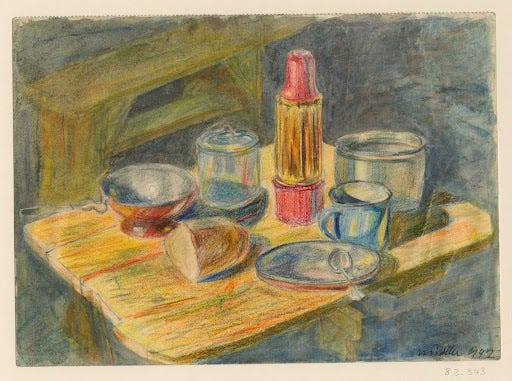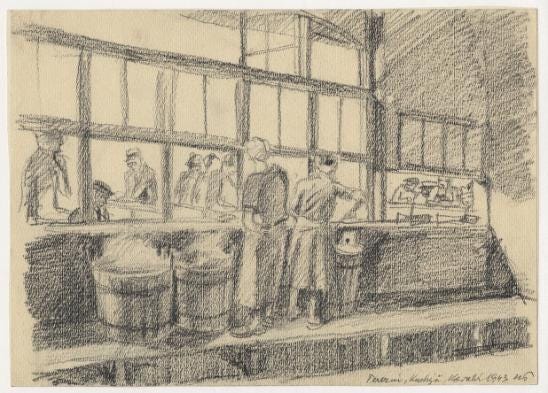
The recipes below are an expansion of last Tuesday’s post that tells the story of a cookbook created by Mina Pachter and other doomed women who were imprisoned in the Nazi concentration camp of Terezin. Mina died in 1944 on Yom Kippur. Her daughter, Anny Stern, published the cookbook, now entitled In Memory’s Kitchen, A Legacy from the Women of Terezín, in 1996. It would be good if you read the previous post for a fuller understanding of the cookbook’s history and importance.
“You imagined it [life] even better than it was, and that’s how it was with food, also. Talking about it helped you.” --Bianca Steiner Brown, a former inmate of Terezin, as quoted by Cara De Silva in her introduction to In Memory’s Kitchen.
Note about the recipes: Most of the people in Terezin were once well-off and considered themselves completely assimilated into German and Czechoslovakian society. They included many illustrious intellectuals, artists and musicians. Others were highly decorated German veterans of World War I. The cookbook’s recipes represent 19th century high-society European cooking: Few would be considered kosher--one specifically calls for pork. The recipes are presented how they were originally written and may seem difficult, incomplete. But the women assumed the readers would have a mastery of cooking, making in-depth explanations unnecessary. Their suffering—their minds and bodies depleted by malnourishment and unimaginable abuse—should also be factored into the vague measurements and directions. Read over them a few times and you should be able to grasp them. The book’s editors provided clarifications in brackets. I’ve tried to transform European measures into American units but it’s best to consider them as approximation. Finally, I’ve arranged the recipes into something like a dinner menu--appetizers, entrée, dessert—for a meal the women may have composed themselves.

Pâté in a Bowl
Make a puff pastry that has been folded 3-4 times. Put a rolled piece of the dough into a mold in which you will bring the pâté to the table. Bake the dough only half way [through] in a hot oven. Now make a big dome from paper on the pâté. Make a border from the dough all around the edge [of the lined mold] and a dough cover and lay it on the greased paper dome. Brush it with egg and bake it in a hot oven.
In the meantime make yourself prepare [sic] the pâté filling: Either young vegetables, or brains with eggs, or mushrooms with eggs. Or a real farce made from roasted veal or chicken, finely chopped, 1 veal brain roasted, 15 decagrams tongue or cooked smoked meat [about 1 1/2 tablespoons], all finely chopped, 3 anchovies, 3 softened rolls, 3 whole eggs, mushrooms, cockscombs. Combine it with a thick béchamel, lemon juice, 1/2 [wine] glass white wine, pâté spice. Taste it and put it into the mold. Carefully lift the [pastry] cover, remove and discard the paper and put the farce as hot as possible into the [lined] mold. Top with the cupola-shaped arched [pastry] cover and sprinkle it with Parmesan and bring it as hot as possible to table.
Potato Herring Dish
Boil about 20 potatoes, peel them quickly and put them through a potato ricer. Add about 5-6 decagrams [give or take 4 teaspoons], butter, 3-4 egg yolks and from the [stiffly beaten] egg whites snow [meringue]. Before, clean 3-4 pieces of herring. Remove the backbone and all bones. Cut them. The cleaned herring should be soaked overnight or for a few hours. Put them on a sieve and dry them. Now mash the herring milt [roe]. Add the cut up herring, 1 cup thick sour cram and from 2 tablespoons flour [make] a béchamel. Now put the very fluffy potatoes into a form [serving dish] in which you will bring it to the table. Make an indentation in the center, pour in this milt [herring] mixture and put it in a very hot oven until the top forms a crust. Bring to the table as hot as possible. Serve with fresh rolls.
Brown remembers women sharing recipes in their bunk late at night. “They would say, ‘Do you know such and such a cake?’” she counts. “I did it in such and such a way.’”--Bianca Steiner Brown quoted by Cara De Silva in her introduction to In Memory’s Kitchen.
Chocolate Strudel or Kapuziener Strudle
Make a strudel dough and stretch it a little thicker than usual. Beforehand make the following mixture: 15 decagrams with 15 decagrams sugar, 15 decagrams grated chocolate [about 1 1/2 tablespoons for each ingredients], 8 egg yolks and from the 8 [stiffly beaten] egg whites snow [meringue]. Spread the mixture on the strudel dough. Bake it in a moderately hot oven, and slice it lukewarm.
Thank you for reading America Eats! I’m so grateful to all who have signed up for a free subscription. Your support helps me bring you stories not often told—and people who should be better remembered and celebrated—in the food world and at the American table. have a good Saturday and see you on Tuesday!



